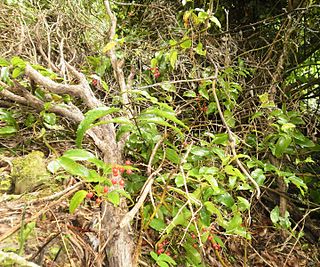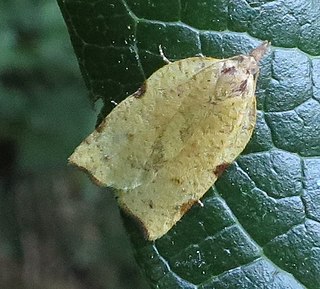
The Archipini are a tribe of tortrix moths. Since many genera of these are not yet assigned to tribes, the genus list presented here is provisional.

Ctenopseustis is a genus of moths belonging to the subfamily Tortricinae of the family Tortricidae.

Ctenopseustis herana, the brownheaded leafroller, is a moth of the family Tortricidae. It is native to New Zealand, where it is found on the South, Stewart and Chatham islands. The common name is also used for related species Ctenopseustis obliquana and Ctenopseustis fraterna.

Ripogonum scandens is a common rainforest vine endemic to New Zealand. The species was described by Johann Reinhold Forster, and Georg Forster in 1776. It has a conservation status of Not Threatened.
Aethes obliquana is a species of moth of the family Tortricidae. It is found in the United States, where it has been recorded from North Carolina, Kentucky and Ohio.

Ctenopseustis fraterna, the brownheaded leafroller or the rusty ponga leaf-tyer, is a species of moth of the family Tortricidae. It is found in New Zealand, where it has been recorded from the North Island only. The common name is also used for the related species Ctenopseustis herana and Ctenopseustis obliquana.

Ctenopseustis filicis, also known as ginger ponga leaf-tyer, is a species of moth of the family Tortricidae. It is endemic to New Zealand and is found in the South and Stewart Islands.
Ctenopseustis servana is a species of moth of the family Tortricidae. It is found in New Zealand, where it has been recorded from the North Island and the Three Kings Islands.
Leucotenes coprosmae is a species of moth of the family Tortricidae. It is found in New Zealand, where it has been recorded from the North and South islands, as well as Stewart Island.
Planotortrix puffini is a species of moth of the family Tortricidae. It is endemic to New Zealand. Specimens have been collected from Lee Bay in Stewart Island.

Apoctena clarkei, also known as the umbrella fern bell moth, is a species of moth of the family Tortricidae. It is found in New Zealand, where it is only found on the North Island.

Apoctena conditana is a species of moth of the family Tortricidae. It is found in New Zealand, where it is found on both the North and South islands.

Apoctena fastigata is a species of moth in the family Tortricidae. It is found in New Zealand, where it is only found on the South Island.

Apoctena flavescens is a species of moth of the family Tortricidae. It is found in New Zealand, where it is found on both the North and South islands.

Apoctena orthropis is a species of moth of the family Tortricidae. It is found in New Zealand, where it is found on both the North and South islands.

Apoctena persecta is a species of moth of the family Tortricidae. It is found in New Zealand, where it is found only on the South Island.

Apoctena syntona is a species of moth of the family Tortricidae. It is found in New Zealand.

Apoctena pictoriana is a species of moth of the family Tortricidae. It is found in New Zealand, where it is found on both the North and South islands.

Apoctena spatiosa is a species of moth of the family Tortricidae. It is found in New Zealand, where it is located on both the North and South islands.
Brownheaded leafroller may refer to three species of moth in the family Tortricidae:


















